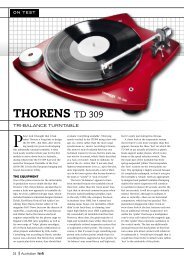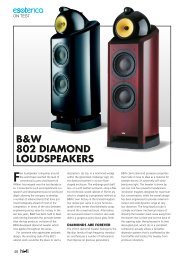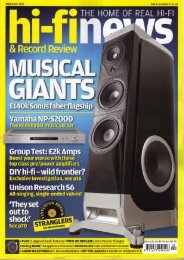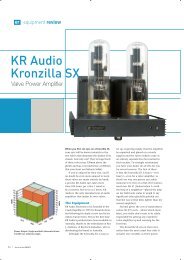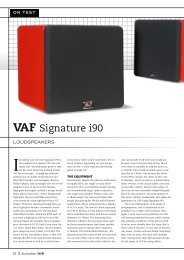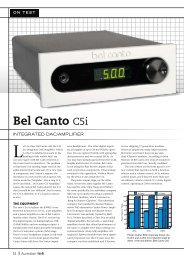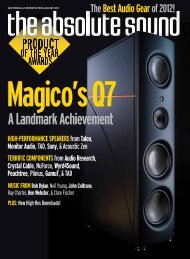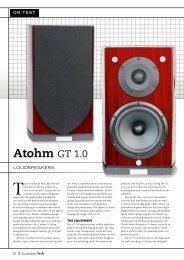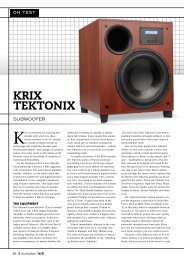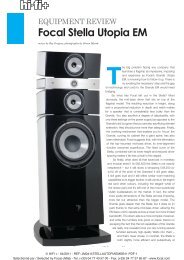here - Ultra High-End Audio and Home Theater Review
here - Ultra High-End Audio and Home Theater Review
here - Ultra High-End Audio and Home Theater Review
You also want an ePaper? Increase the reach of your titles
YUMPU automatically turns print PDFs into web optimized ePapers that Google loves.
Orpheus Apollo VI Loudspeakers<br />
O N T E S T<br />
copper tracks. This theme is continued with<br />
the internal cabling, which is all Wireworld<br />
MiniEclipse 5², a wire design that comprises<br />
non-str<strong>and</strong>ed flat copper conductors (16awg -<br />
1.25mm²) encapsulated in circular insulation<br />
sheaths The cables are soldered to both the<br />
crossover network <strong>and</strong> the driver terminals.<br />
Orpheus has evidently put a lot of<br />
thought <strong>and</strong> work into its ‘new’ non-curved<br />
cabinet, so that it varies in thickness from<br />
18mm to 25mm depending on the panel<br />
location <strong>and</strong> is heavily internally braced. I<br />
counted three different types of foam used internally.<br />
The bass reflex port, which is located<br />
on the front baffle <strong>and</strong> t<strong>here</strong>fore simplifies<br />
speaker placement, is curiously short (70mm)<br />
<strong>and</strong> 65mm in length. The speakers Orpheus<br />
supplied for our review were its showroom<br />
samples <strong>and</strong> were finished in black oak<br />
veneer—the veneer being real timber, rather<br />
than a vinyl. I liked the black oak finish, <strong>and</strong><br />
our photographer took some nice images of<br />
them, but when I saw the photos Orpheus<br />
supplied, which were of the same model<br />
finished in Mahogany (the other available<br />
veneer), I immediately knew which finish I<br />
preferred, so I’ve used Orpheus’ stock photographs<br />
to illustrate this review. Each cabinet<br />
measures 980×220×325mm (HWD).<br />
Listening Sessions<br />
The Orpheus speakers are very ‘room-friendly’<br />
because of the location of their drivers<br />
on the front baffle, <strong>and</strong> the fact that the<br />
port is also on the front baffle. Even better,<br />
I found that—at least in my room—they<br />
sounded most impressive when they were<br />
pushed back almost touching the wall. Yes, I<br />
could get more ‘air’ around the highs when I<br />
moved the speakers about a metre out from<br />
the room, but I preferred the increase in bass<br />
from having them closer to the wall.<br />
I think you’ll notice the quality of the<br />
bass from the moment you start auditioning,<br />
because it’s very much ‘t<strong>here</strong>’—so much<br />
‘t<strong>here</strong>’ that it was, perhaps, just a tad forward<br />
in my listening room, but as I pointed out,<br />
that was my choice. If I’d moved the speakers<br />
further away from the wall it would have<br />
balanced out the bass nicely—I just chose<br />
not to. Either way, the actually quality of the<br />
bass is excellent. It’s fast, tight <strong>and</strong> exciting,<br />
with absolutely no ‘honk’ or other upper-bass<br />
colourations audible. The low-frequency extension<br />
Orpheus has achieved is exceptional<br />
considering the relatively small size of the<br />
drivers <strong>and</strong> the enclosure. Those super-light<br />
paper cones <strong>and</strong> large driving magnets are<br />
obviously delivering big-time!<br />
The light-weight cones have also allowed<br />
Orpheus to run the bass/midrange drivers up<br />
higher in frequency than synthetic cones,<br />
which has meant that despite being a true<br />
two-way design, the midrange is tonally<br />
identical to the bass. The midrange also<br />
turned out to be very smooth, most noticeably<br />
so when reproducing vocals, which were<br />
rendered gloriously. If you’re a fan of choral<br />
music, or a capella vocal ensembles, you’ll<br />
love the Apollo VIs.<br />
<strong>High</strong>-frequency performance was very<br />
good too, though I’d add the proviso that<br />
you should angle the speakers so they face<br />
the listening position, as the tweeter gives of<br />
its best when you’re on axis. This means you<br />
should also tilt the speakers if necessary to<br />
get the tweeters aimed at ear-height (easily<br />
done with spikes). One advantage of the<br />
large tweeter dome was that I could play back<br />
music at very high levels for extended periods<br />
yet still have the tweeter delivering the full<br />
quotient of high-frequency information.<br />
Smaller tweeters, which often have inadequate<br />
heat dissipation, mostly lose their efficiency<br />
under such situations, resulting in a<br />
reduction in the level of the high frequencies.<br />
However, I should also note that I did have<br />
to keep a weather eye on volume levels when<br />
playing the Apollo VIs. Although they will<br />
happily play very loudly with almost all types<br />
of music, I did find that with orchestral works<br />
I needed to lower the volume somewhat to<br />
ensure maximum clarity.<br />
I was also pleased to find the Apollo VIs<br />
are as amplifier-friendly as they are roomfriendly.<br />
During the course of the review,<br />
which had them linked to any number of<br />
amplifiers variously rated between 60-watts<br />
per channel <strong>and</strong> 180-watts per channel, I also<br />
trialled them with the lowest-powered amplifier<br />
I had on h<strong>and</strong> (10-watts!) as well as with<br />
a budget 40-watt home theatre receiver <strong>and</strong><br />
the Apollo VIs performed very nearly<br />
as well with these low-powered units<br />
as they had with the high-powered<br />
high-end amplifiers I used.<br />
Conclusion<br />
T<strong>here</strong>’s no getting around it, Orpheus’s<br />
Apollo VI speakers are beautifully crafted,<br />
<strong>and</strong> the result of this is that they sound ‘just<br />
right.’ Give them an audition <strong>and</strong> I am sure<br />
you will agree! greg borrowman<br />
ORPHEUS APOLLO VI<br />
LOUDSPEAKERS<br />
Br<strong>and</strong>: Orpheus<br />
Model: Apollo VI<br />
Category: Floorst<strong>and</strong>ing Loudspeakers<br />
RRP: $2,000<br />
Warranty: Five Years<br />
Distributor: Orpheus Loudspeakers<br />
Address: Unit 4, 26 Stanley Street<br />
Peakhurst NSW 2210<br />
(02) 9584 1822<br />
(02) 9584 1708<br />
info@orpheusaudio.com.au<br />
www.orpheusaudio.com.au<br />
• Great bass<br />
• Very efficient<br />
• Easy to drive<br />
• Limited number of<br />
cabinet finishes<br />
• Rectangular<br />
LAB REPORT<br />
cabinet design<br />
Readers interested in a full technical<br />
appraisal of the performance of<br />
the Orpheus Apollo VI Loudspeakers<br />
should continue on <strong>and</strong> read the<br />
LABORATORY REPORT published on<br />
page 101. Readers should note that<br />
the results mentioned in the report,<br />
tabulated in performance charts <strong>and</strong>/<br />
or displayed using graphs<br />
<strong>and</strong>/or photographs should<br />
be construed as applying only<br />
to the specific sample tested.<br />
Lab Report on page 101<br />
avhub.com.au<br />
31



